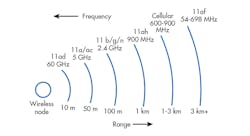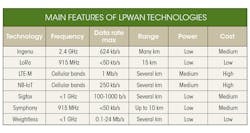What’s the Difference Between IEEE 802.11ah and 802.11af in the IoT?
Download this article in PDF format.
The IEEE standard 802.11 usually defines what we all know as Wi-Fi. Multiple versions of this standard exist, but not all are designated as Wi-Fi despite their being a part of the family. Specifically, consider two relatively recent versions of the standard: 802.11af, now referred to as White-Fi, and 802.11ah, otherwise known as HaLow. Both versions, which are more suited to Internet of Things (IoT) applications, offer benefits beyond traditional Wi-Fi, including longer range and lower power consumption.
This article takes a closer look at these standards, either of which could be the solution to your next design.
IoT Requirements
Most IoT applications involve sensors transmitting minimal data from remote locations over short distances. A core requirement is low power consumption—most applications are battery-operated, so long battery life is a must.
Another burgeoning need is longer range. Most IoT applications cover short range from 10 to say 100 meters. However, many others need to extend that range from 100 meters to many kilometers. Low data rates (less than 1 Mb/s) are typical.
Traditional wireless technologies such as Wi-Fi, Bluetooth, ZigBee, and others can easily handle the short-range applications, but their operating frequency limits that range. Power consumption may be an issue, too.
The distance traveled by a radio wave of a given power, antenna gain, and receiver sensitivity directly relates to the operating frequency. The physics of radio indicates that the range is inversely related to frequency. In other words, lower-frequency signals naturally travel farther than higher-frequency signals.
These are the approximate maximum ranges of 802.11 wireless technologies. Environment, obstacles, etc. can shorten or lengthen these ranges.
Most of the basic short-range technologies operate in the 2.4-GHz band, or 5 GHz. However, range can be extended with higher power up to the imposed FCC limits and by using gain antennas.
Using a lower frequency also extends range. For the same power, along with other factors, dropping the operating frequency below 1 GHz will dramatically extend the useful range. Another benefit of lower-frequency signals is that they penetrate buildings and other obstacles better than higher frequencies. In fact, non-line-of-sight (NLOS) operation is possible. The 802.11af and 802.11ah standards take advantage of the characteristics provided by these lower frequencies (< 1 GHz).
The Wi-Fi Option
If your application requires high data rates and the expected range is less than 100 meters, a conventional Wi-Fi radio may be your best bet. Examples include video monitoring in the home or some commercial/industrial use requiring internet access and good security.
The widely used 802.11n standard can produce speeds to 300 Mb/s. The more recent 802.11ac operates in the 2.4- or 5-GHz bands and achieves speeds in excess of 1.3 Gb/s. The main limitations are a range of up to 100 meters, depending on the environment, and medium to high power consumption. Higher data rate needs can be met, though, with the 802.11ad WiGig option operating at 60 GHz. Range is typically less than 10 meters, but speeds can reach up to 7 Gb/s. Other choices are available if you need longer range and lower power consumption.
The figure shows the estimated maximum ranges for the 802.11 standards. Keep in mind that the environment, terrain, obstacles, and other factors either shorten or lengthen those approximations.
Long-Range, Low-Power Options
If you’re looking for a long-range, low-power wireless solution, lots of choices are available. Table 1 lists the primary alternatives for building a low-power wide area network (LPWAN) with extended range. Space doesn’t permit a comprehensive discussion of each, but more background information is available in the article “Long-Range IoT on the Road to Success."
The choices boil down into two groups: proprietary, non-standard technologies and cellular. Cellular is an interesting choice, as it provides excellent range and reliable coverage with existing networks. The downsides for some applications are high cost and high power consumption. Proprietary technologies cover many use cases, so some evaluation is needed. Then again, the IEEE standards may simply be the answer.
HaLow (802.11ah)
This standard can use any industrial-scientific-medical (ISM) frequency spectrum below 1 GHz, but the primary targeted band is the 902- to 928-MHz license-free band in the U.S. Similar bands just below 1 GHz are found in other countries, such as 863-868 MHz in Europe, 717-723 MHz in Korea, 916-927 MHz in Japan, and 755-787 MHz in China. This is good news because low power can be used over these lower frequencies, enabling battery-operated equipment. While most Wi-Fi gear has a maximum range of 100 meters under ideal conditions, HaLow can reach up to a kilometer with the right antenna.
The 902- to 928-MHz spectrum offers 26 MHz of bandwidth that’s divided into 1-, 2-, 4-, 6-, or 16-MHz channels. The 11ah modulation scheme is orthogonal frequency-division multiplexing (OFDM) using 24 subcarriers in a 1-MHz channel and 52 data subcarriers in the larger bandwidths. Modulation can be BPSK, QPSK, or 16QAM, 64QAM, or 256QAM with multiple coding options, providing for a wide range of data rates. Rates of 100 kb/s in a 1-MHz channel and up to several hundred megabits per second in a 16-MHz channel are easily achieved.
The real goal of 11ah is low power. The typical user station has a sleep mode to conserve battery charge. Short data packets and shortened contention access procedures minimize transmit time and power usage.
The standard supports a massive number of possible network stations (8191). A special station type is the relay access point, which helps all other stations pass along messages over longer distances at low power.
Support is also provided for up to four spatial data streams to further boost data rate. In addition, the antenna-sectorization feature partitions the coverage area.
The 802.11ah standard is blessed by the Wi-Fi Alliance (WFA), which gave it the trade name HaLow. The WFA says that it will implement one of its testing and certification programs for HaLow by 2018.
HaLow is a sophisticated technology that has yet to be widely adopted. Nevertheless, it’s still worthy of consideration for new projects.
White-Fi (802.11af)
White Fi, also known as Super Wi-Fi, is designed to use the TV white spaces (TVWS) or the unused TV channels from 54 to 698 MHz. These channels are ideal to support long-range and non-line-of-sight transmission. The standard employs cognitive-radio technology and geolocation database access to ensure that there’s no interference to local TV signals or other services operating in this region (e.g., wireless microphones). The base station queries a database to see what channels are available locally for data transmission.
The 802.11af standard works with TV channels that have bandwidths of 6, 7, or 8 MHz. Modulation is OFDM using BPSK, QPSK, 16QAM, 64QAM, or 256QAM. A wide range of coding rates allow for optimization of the connection. The maximum data rate per 6-MHz channel is about 24 Mb/s. A typical mobile user station can have a transmit power of 100 mW, while a base station or access point has up to 4 W of power.
Range depends on the actual frequency. Several kilometers can be achieved at the higher frequencies. Even longer ranges of up to several miles are possible at the lower VHF TV frequencies.
This standard isn’t part of the Wi-Fi Alliance family, unlike 802.11ah. Its main competition is the Weightless group of TVWS open standards and some proprietary designs. Few, if any, actual operating networks have been implemented.
Technologies Looking for Adopters
Though both of these standards are viable options for new IoT applications, activity with them hasn’t been visible. For low-speed, long-range, and low-power use cases, both technologies offer superior benefits. What’s hindered their adoption is the fact that they joined the IoT movement late in the game, and the competition is fierce.
The 11ah and 11af standards aren’t only battling the long-range vendors listed in the table, but also some of the other traditionally short-range wireless technologies that can offer extended range in the popular 2.4-GHz band. One example is 802.15.4-based technologies like ZigBee—a ZigBee option offers 902- to 928-MHz operation. Newer versions of Bluetooth may be another longer-range option, depending pon the environment and equipment.
As you pursue new IoT or M2M projects, keep your mind open to 11ah and 11af as possible solutions.
About the Author

Lou Frenzel
Technical Contributing Editor
Lou Frenzel is a Contributing Technology Editor for Electronic Design Magazine where he writes articles and the blog Communique and other online material on the wireless, networking, and communications sectors. Lou interviews executives and engineers, attends conferences, and researches multiple areas. Lou has been writing in some capacity for ED since 2000.
Lou has 25+ years experience in the electronics industry as an engineer and manager. He has held VP level positions with Heathkit, McGraw Hill, and has 9 years of college teaching experience. Lou holds a bachelor’s degree from the University of Houston and a master’s degree from the University of Maryland. He is author of 28 books on computer and electronic subjects and lives in Bulverde, TX with his wife Joan. His website is www.loufrenzel.com.



